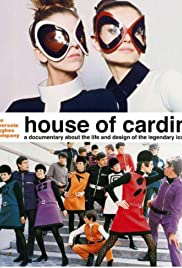
HOUSE OF CARDIN
US/France, 2019, 95 minutes, Colour.
Directed by P.David Ebersole, Todd Hughes.
“A magazine cover reaches millions of people�. A passing remark in this documentary about Pierre Cardin (born in Italy, Pietro Cardine, is family fleeing was Selena’s fascism to France when the boy was two). His career is one of the epitomes of French fashion success, a member of the French Academie. On the day that this reviewer watched this documentary about him, he had turned 98 the day before, July 2nd.
Devotees of fashion have been very well served by feature-length documentaries in recent years, portraits of Christian Dior, Eve St Laurent, Coco Chanel, Vivian Westwood, Alexander McQueen…? This one makes for interesting and arresting viewing.
It is full of energy, continually on the move, images, many images, of clothes and design, models from Europe, the Americas, and, especially Asia and Japan, intercutting the narrative. (There is an enormous credit list at the end, noting the sources of so many of the images of Cardin’s creations.) And, it is not only the dresses and suits, formal and informal (“modern� is mentioned so often), but also the range of furniture, home objects, large and small designs that feature throughout. And, not content with this creativity, Cardin has opened theatres, sponsored festivals, invited all kinds of performers, avant-garde and traditional, Marlene Dietrich, Dionne Warwick, Alice Cooper… And theatrical, ballet and dance events.
We take it for granted when Pierre Cardin explains that his life is work. And, as that is repeated throughout the film, enormous amounts of the evidence is there. He loves to work. In fact, for those who know nothing about him and his life, the would begin to wonder whether he has any private life at all. About 20 minutes before the end of the film, there is some mention about his life, his companionship with actress Jeanne Moreau, his relationship with Andre Oliver, his main assistant for over 40 years. But, that is about all. And, given his work and accomplishment, there would not seem to have been much time for any kind of private life.
And, right throughout the film, there is Cardin himself. Photos of when he was young, working with the Red Cross in Vichy France during the war, coming to Paris in 1945, dress designs for a Jean Cocteau film, encouraged by Dior in 1946, 1950 going out on his own, many images of his shopfronts (and his name in lights, even on the Great Wall of China), film footage of him at work, with models, catwalks… And, then, even more footage and photos of him as he moves towards middle age, more as he moves into late middle age. And, in the decades of video and social media, plenty of footage of him in old age. And, for the film itself, the he is, a powerful and genial presence in his 90s, always involved, commenting on his work, making the audience, even those who know very little of him, pleased to make something of his acquaintance.
Not a biography of the man at all, a portrait. Rather, a biography of his work, his creativity.